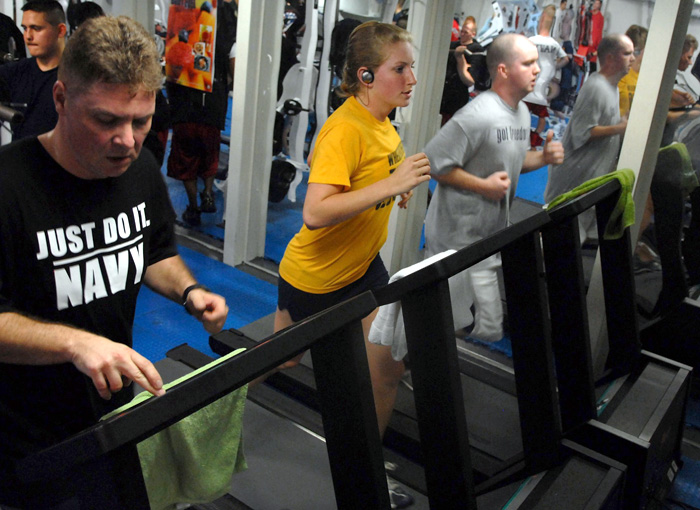The beep test, a 20-meter incremental shuttle run test, was first described in 1982 and since then it has become one of the most widely used aerobic fitness tests around the world. The reason for its popularity is that it is simple to conduct, can test large groups at once, requires minimal equipment, takes up minimal space, and has been shown to accurately estimate VO2max. However, sometimes the beep test may not suit your situation. Here are some alternatives to the beep test that you should consider.
Modifications of the Beep Test
If an incremental test to exhaustion like the beep test is what you are after, then some of the modifications may suit your group better. There are beep tests for swimmers, rugby referees, those in a wheelchair, ice hockey players, rowers, the elderly, and many more modifications.
Tests Requiring Minimal Equipment
There are other aerobic tests that also do not require expensive equipment to conduct. To test large groups, the outdoor walking or running tests are normally conducted around an athletics track or sporting oval. In these tests the participants run or walk for a set distance or time, such as the Cooper 12 minute Test where they try and cover as much distance as they can in 12 minutes.
Indoor Beep Test Alternatives
One of the great advantages of the beep test is that it can be conducted indoors if needed, a standard basketball court area is usually enough. But if even that space is not available, there are many aerobic tests that can be conducted using standard gym equipment. Although large groups can not usually be tested at once, there are many aerobic tests to be done on a cycle ergometer or treadmill. There are several common treadmill incremental running tests to exhaustion, such as the Balke and Bruce protocols.
 Treadmill tests are an alternative to the beep test
Treadmill tests are an alternative to the beep testMore Specific Intermittent Tests
The beep test protocol has evolved to better suit intermittent sport athletes. The Yo-Yo Test is a beep-type shuttle test with rest periods to simulate the demands of some field team sports. The Yo-Yo test involves running between markers placed 20 meters apart, at increasing speeds, until exhaustion. The timings of the test is different from the beep test, though the main difference with the yo-yo test is that in the commonly used version, there is a 10-second recovery period between 40m runs.
Another beep type intermittent test is the 30-15 Intermittent Fitness Test / Interval Shuttle Run Test, which involves 40m shuttles with a 30:15 second work:rest ratio. See testing for intermittent sports.
Submaximal Tests
A maximal exercise test like the beep test is not suitable for some people. There are submaximal aerobic tests, such as the step test. Step Tests do not require expensive equipment and are simple to conduct, though testing is usually for only one athlete at a time. The athlete steps up-and-down on a raised platform at a given rate for a certain time. Heart rate may be recorded during the test and/or for some period afterwards.
Related Pages
- Complete List of Aerobic Fitness Tests.
- For a comprehensive listing of information about the Beep Test, see the Beep Test Home.
- Modified Beep tests for testing different groups
- Discussion about some beep test variations
- Can I do the beep test on a treadmill?
- Free download of the beep test mp3
- Videos of Beep Tests including many variations
- What is the beep test called around the world?
- Maximizing Your Score — to get the most out of the beep test.
- Test Procedure — Detailed instructions for conducting the beep test. Also video examples.
- Calculating Your Score — calculator to determine your VO2max equivalent score.
- Guide to Purchasing the beep test cd
- What's your best score? some results of athletes.
- Beep Test Software — provides the standard Multistage Fitness Test or Bleep Test right on your PC or Laptop, with many additional features.
BEEP TEST PACKAGE - only $10
The 20m Beep Test (male & female voices) + Training Levels + 'Beeps Only' track + Excel Spreadsheet + eBook Guide (PARQ, consent form, test recording sheet, warm-up, tips, norms + much more!)

The ultimate beep test package, including two versions of the beep test audio file (male and female voice), an audio track with only the beeps (no voices), 8 audio tracks for training at specific test levels, an Excel spreadsheet with an offline calculator and tables for recording, analyzing and presenting results, a 12-page eBook beep test guide which includes a PARQ, informed consent form, and test recording sheet plus much more. All these files are available individually for $5 each, or even better get them all for $10. Check out the details.


 Current Events
Current Events